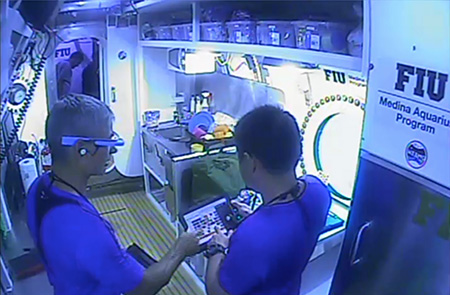|
The crew of NEEMO 21 will use Playbook, Ames's mobile crew self-scheduling tool.
(Jul 12, 2016)
Crew members will use the Ames mobile mission planning tool Playbook along with mission controllers on the NASA Extreme Environments Mission Operations (NEEMO) 21 mission this July to prepare for upcoming crew self-scheduling studies on the International Space Station (ISS) in November. A key goal for Playbook on NEEMO 21, which starts on July 18th 2016, is to assess crews' ability to reschedule some of their own activities without input from ground and allow the NEEMO mission to better simulate time-delay, a necessary area of research for future manned deep space missions and increased crew autonomy on the ISS.
Previously this was highlighted on the NEEMO 20 mission where crew members successfully planned and re-planned four of their Extra Vehicular Activities (EVAs) using the Playbook tool. This year for NEEMO 21 Playbook will be improving and extending these capabilities for EVA self-scheduling by allowing crew members to create and edit their own activities on the fly and to easily schedule groups of activities, which will allow for greater crew autonomy and make self-scheduling even more efficient. In addition the Playbook team has added in more functionality to the Mission Log: a text, photo, and video communication tool for crew and mission control to communicate in a communication time delay environment. This feature has been enhanced this year with the ability to send priority messages, which are messages that are highly visible and must be explicitly acknowledged, ensuring mission control or the crew that the message they sent was seen, received, and understood. The other major feature is the ability to search all messages in real time, to allow mission control and the crew to easily refer back to past messages, or to see all messages regarding a certain topic or phrase. These features allows faster, more efficient communication and can provide more context than voice, such as troubleshooting an experiment by easily sharing a video or photo message from your tablet vs. having to describe the problem over the voice loops.
Playbook has been specifically adapted to support time-delayed communications for this mission. While Playbook was used for mission operations during NEEMO 20, the Ames Human-Computer Interaction (HCI) team from the Human Systems Integration Division collected data on the functionality and usability of the system. The Playbook planning tool has heritage back to the Mars Exploration Rover mission, the Phoenix Mars Lander mission, the Mars Science Laboratory, and the International Space Station (ISS) crew activity planning by ground controllers at Johnson Space Center. Unlike those applications, however, this version of Ames' flagship planning system is specifically designed for use by crew (rather than by mission controllers). It was created for use on mobile devices including iPads and iPhones but also runs on regular computers and laptops. Playbook allows the crew and controllers to view and manipulate timelined mission activities, capture the Mission Log (along with associated pictures and video), and access procedures for all mission activities. Playbook was designed to require minimal training, and crew use so far indicates that this has been very successful. The Ames HCI team will continue to collect data on functionality and usability of the system for NEEMO 21.
 |